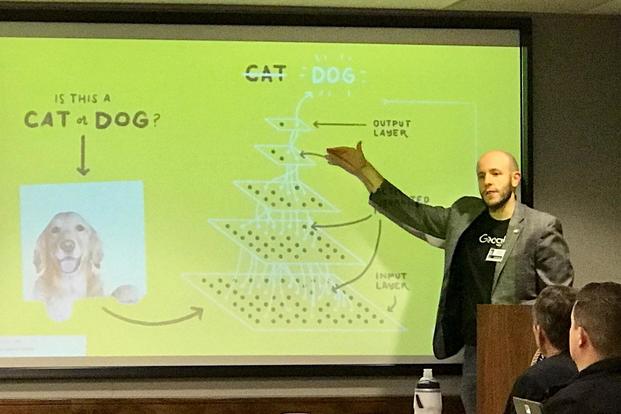A team of experts, part of the Air Force's Physiological Episodes Action Team, or AF PEAT, recently held a day-long event to trade ideas on how best to curb hypoxia-like events from happening to pilots across the ranks.
Pilots, physiologists, data scientists, engineers and maintenance personnel took part in the event, known as an AF PEAT hackathon, outside Washington, D.C., in December to find solutions to physiological phenomena that continue to plague pilots flying aircraft such as the T-6 Texan II, F-22 Raptor, F-15 Eagle, F-35 Lightning II and A-10 Thunderbolt II.
Surprising among the industry leaders at the table?
Google.
Senior artificial intelligence managers with the tech giant participated in the hackathon, giving Air Force officials a glimpse into how the services can leverage developing technologies faster, according to a news release.
Related content:
- New Device Helps Fighter Pilots Urinate. And Possibly Saves Lives
- Congress Wants Air Force, Navy to Solve Pilot Physical Episodes Now
- With Google Out of Maven, DoD Still Wants AI to Sort Surveillance Data
- Cobham Gets Pentagon Contract to Develop Pilot Life Support System
"We're moving from a null set of data regarding humans in the loop, to an overwhelming big data challenge," said Brig. Gen. Edward Vaughan, the AF PEAT team lead.
"We will lean heavily on industry experts to help us collect, model and apply these data," Vaughan said of Google's participation. Tony Carnevale, a Google solutions architect, gave a presentation on how machine learning and A.I. could aid the process, according to the release.
The Silicon Valley company's latest involvement comes months after Google announced it would not pursue another contract with the Pentagon's Project Maven -- an AI system that sifts through collected drone and surveillance data -- after the current agreement expires in 2019.
Company employees reportedly voiced concerns about their work being used by the military for deadly warfare.
"Working closely with the Navy, NASA and other industry partners, the Air Force is making huge strides to better understand and solve issues," Vaughan said in the release. "We are in a period of very positive, but disruptive, innovation. There are hundreds of efforts across the human physiology and aircraft ecosystems moving in many directions."
The Defense Department has been unable to find a root cause for pilots experiencing hypoxia-like symptoms -- disorientation, shortness of breath, confusion and wheezing, among other manifestations. In April, Air Force Chief of Staff Gen. David Goldfein said the manifestations may not be hypoxia in some cases, but instead hypocapnia, or reduced carbon dioxide in the blood. Hypocapnia often presents symptoms similar to hypoxia, such as dizziness and disorientation.
Amid the spate of physiological events and ongoing aviation accidents, lawmakers in the 2019 National Defense Authorization Act stood up the National Commission on Military Aviation Safety to review crashes, mishaps and phenomena that occurred between 2013 and 2018.
During the hackathon, AF PEAT members reviewed "coordination and communication between research, sensor development, and system improvements/redesign from the T-6 Texan II level, across other aircraft, and all the way up through Department of Defense level," the release states.
The event emphasized a renewed focus on people.
"Physiological episodes happen to people, not equipment," said Jennifer Farrell, chief engineer for the Air Force Life Cycle Management Center Human Systems Program Office. "We must focus on design that enhances the human element."
Last year, lawmakers criticized Air Force and Navy leaders over hypoxia-related incidents that were occurring in various aircraft because they believed top brass had not been honoring their obligation to pilots.
During a House Armed Services Tactical Air and Land Forces Subcommittee hearing, Lt. Gen. Chris Nowland, then the service's deputy chief of staff for operations, testified the Air Force needed to enhance training and explore how maintainers and engineers were looking at individual aircraft systems.
Rep. Mike Turner, R-Ohio, said he was very disappointed in Nowland's remarks, once again turning the conversation back to the system rather than focus on pilots' needs.
"No one ever came to us and tried to blame the pilots, and say it is just an issue of training," Turner said during the hearing in February.
Lt. Gen. Mark Kelly, Nowland's successor, has tasked Vaughan to accelerate ongoing conversation on the issue, push for faster innovation and creative disruption, test new sensors and "drastically expand collaboration" across the Pentagon with industry's help, the release said.
-- Oriana Pawlyk can be reached at oriana.pawlyk@military.com. Follow her on Twitter at @Oriana0214.










